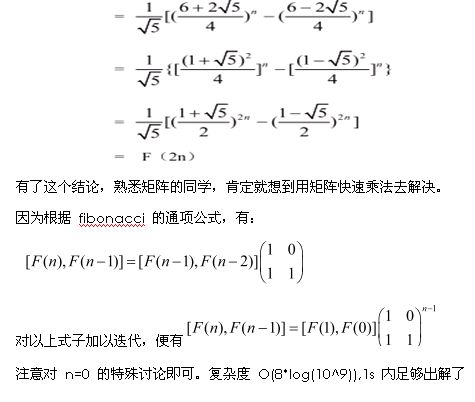Fibonacci Check-up
Time Limit: 2000/1000 MS (Java/Others) Memory Limit: 32768/32768 K (Java/Others)Total Submission(s): 900 Accepted Submission(s): 507
Problem Description
Every ALPC has his own alpc-number just like alpc12, alpc55, alpc62 etc.
As more and more fresh man join us. How to number them? And how to avoid their alpc-number conflicted?
Of course, we can number them one by one, but that’s too bored! So ALPCs use another method called Fibonacci Check-up in spite of collision.
First you should multiply all digit of your studying number to get a number n (maybe huge).
Then use Fibonacci Check-up!
Fibonacci sequence is well-known to everyone. People define Fibonacci sequence as follows: F(0) = 0, F(1) = 1. F(n) = F(n-1) + F(n-2), n>=2. It’s easy for us to calculate F(n) mod m.
But in this method we make the problem has more challenge. We calculate the formula , is the combination number. The answer mod m (the total number of alpc team members) is just your alpc-number.
, is the combination number. The answer mod m (the total number of alpc team members) is just your alpc-number.
As more and more fresh man join us. How to number them? And how to avoid their alpc-number conflicted?
Of course, we can number them one by one, but that’s too bored! So ALPCs use another method called Fibonacci Check-up in spite of collision.
First you should multiply all digit of your studying number to get a number n (maybe huge).
Then use Fibonacci Check-up!
Fibonacci sequence is well-known to everyone. People define Fibonacci sequence as follows: F(0) = 0, F(1) = 1. F(n) = F(n-1) + F(n-2), n>=2. It’s easy for us to calculate F(n) mod m.
But in this method we make the problem has more challenge. We calculate the formula
 , is the combination number. The answer mod m (the total number of alpc team members) is just your alpc-number.
, is the combination number. The answer mod m (the total number of alpc team members) is just your alpc-number.
Input
First line is the testcase T.
Following T lines, each line is two integers n, m ( 0<= n <= 10^9, 1 <= m <= 30000 )
Following T lines, each line is two integers n, m ( 0<= n <= 10^9, 1 <= m <= 30000 )
Output
Output the alpc-number.
Sample Input
2 1 30000 2 30000
Sample Output
1 3
Source
Recommend
gaojie
这个如果能够推出答案当然就能求出数据,
但是难就难在你推不出来。。。
诶,这是真的有点困难。
贴出别人的推导过程:
贴出自己的代码:
#include <stdio.h>
#include <string.h>
#include <iostream>
#include <string>
using namespace std;
int N, M;
struct Matrix
{
int date[2][2];
void setE()
{
for (int i = 0; i < 2; i++)
{
for (int j = 0; j < 2; j++)
{
date[i][j] = (i == j);
}
}
}
Matrix Mul(Matrix m)
{
Matrix e;
for (int i = 0; i < 2; i++)
{
for (int j = 0; j < 2; j++)
{
e.date[i][j] = 0;
for (int k = 0; k < 2; k++)
{
e.date[i][j] += (long long int)date[i][k] * m.date[k][j] % M;
}
e.date[i][j] %= M;
}
}
return e;
}
}mat;
Matrix quick_pow(Matrix m, int n)
{
Matrix ans;
ans.setE();
while (n)
{
if (n & 1)
{
ans = ans.Mul(m);
}
m = m.Mul(m);
n >>= 1;
}
return ans;
}
int main()
{
int T;
while (scanf("%d", &T) != EOF)
{
while (T--)
{
scanf("%d%d", &N, &M);
if (N == 0)
{
printf("0\n");
continue;
}
mat.date[0][0] = 0;
mat.date[0][1] = 1;
mat.date[1][0] = 1;
mat.date[1][1] = 1;
Matrix m = quick_pow(mat, 2 * N - 1);
printf("%d\n", (m.date[0][0] + m.date[1][0]) % M);
}
}
// system("pause");
return 0;
}


























 1531
1531

 被折叠的 条评论
为什么被折叠?
被折叠的 条评论
为什么被折叠?








